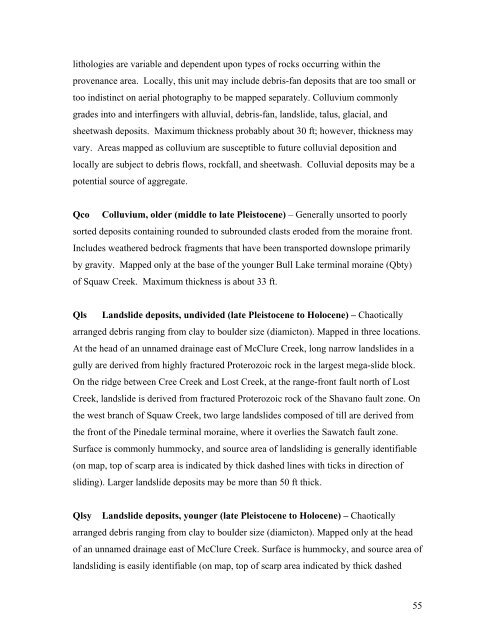Geologic Map of the Maysville Quadrangle, Chaffee County, Colorado
Geologic Map of the Maysville Quadrangle, Chaffee County, Colorado
Geologic Map of the Maysville Quadrangle, Chaffee County, Colorado
Create successful ePaper yourself
Turn your PDF publications into a flip-book with our unique Google optimized e-Paper software.
lithologies are variable and dependent upon types <strong>of</strong> rocks occurring within <strong>the</strong><br />
provenance area. Locally, this unit may include debris-fan deposits that are too small or<br />
too indistinct on aerial photography to be mapped separately. Colluvium commonly<br />
grades into and interfingers with alluvial, debris-fan, landslide, talus, glacial, and<br />
sheetwash deposits. Maximum thickness probably about 30 ft; however, thickness may<br />
vary. Areas mapped as colluvium are susceptible to future colluvial deposition and<br />
locally are subject to debris flows, rockfall, and sheetwash. Colluvial deposits may be a<br />
potential source <strong>of</strong> aggregate.<br />
Qco Colluvium, older (middle to late Pleistocene) – Generally unsorted to poorly<br />
sorted deposits containing rounded to subrounded clasts eroded from <strong>the</strong> moraine front.<br />
Includes wea<strong>the</strong>red bedrock fragments that have been transported downslope primarily<br />
by gravity. <strong>Map</strong>ped only at <strong>the</strong> base <strong>of</strong> <strong>the</strong> younger Bull Lake terminal moraine (Qbty)<br />
<strong>of</strong> Squaw Creek. Maximum thickness is about 33 ft.<br />
Qls Landslide deposits, undivided (late Pleistocene to Holocene) – Chaotically<br />
arranged debris ranging from clay to boulder size (diamicton). <strong>Map</strong>ped in three locations.<br />
At <strong>the</strong> head <strong>of</strong> an unnamed drainage east <strong>of</strong> McClure Creek, long narrow landslides in a<br />
gully are derived from highly fractured Proterozoic rock in <strong>the</strong> largest mega-slide block.<br />
On <strong>the</strong> ridge between Cree Creek and Lost Creek, at <strong>the</strong> range-front fault north <strong>of</strong> Lost<br />
Creek, landslide is derived from fractured Proterozoic rock <strong>of</strong> <strong>the</strong> Shavano fault zone. On<br />
<strong>the</strong> west branch <strong>of</strong> Squaw Creek, two large landslides composed <strong>of</strong> till are derived from<br />
<strong>the</strong> front <strong>of</strong> <strong>the</strong> Pinedale terminal moraine, where it overlies <strong>the</strong> Sawatch fault zone.<br />
Surface is commonly hummocky, and source area <strong>of</strong> landsliding is generally identifiable<br />
(on map, top <strong>of</strong> scarp area is indicated by thick dashed lines with ticks in direction <strong>of</strong><br />
sliding). Larger landslide deposits may be more than 50 ft thick.<br />
Qlsy Landslide deposits, younger (late Pleistocene to Holocene) – Chaotically<br />
arranged debris ranging from clay to boulder size (diamicton). <strong>Map</strong>ped only at <strong>the</strong> head<br />
<strong>of</strong> an unnamed drainage east <strong>of</strong> McClure Creek. Surface is hummocky, and source area <strong>of</strong><br />
landsliding is easily identifiable (on map, top <strong>of</strong> scarp area indicated by thick dashed<br />
55




